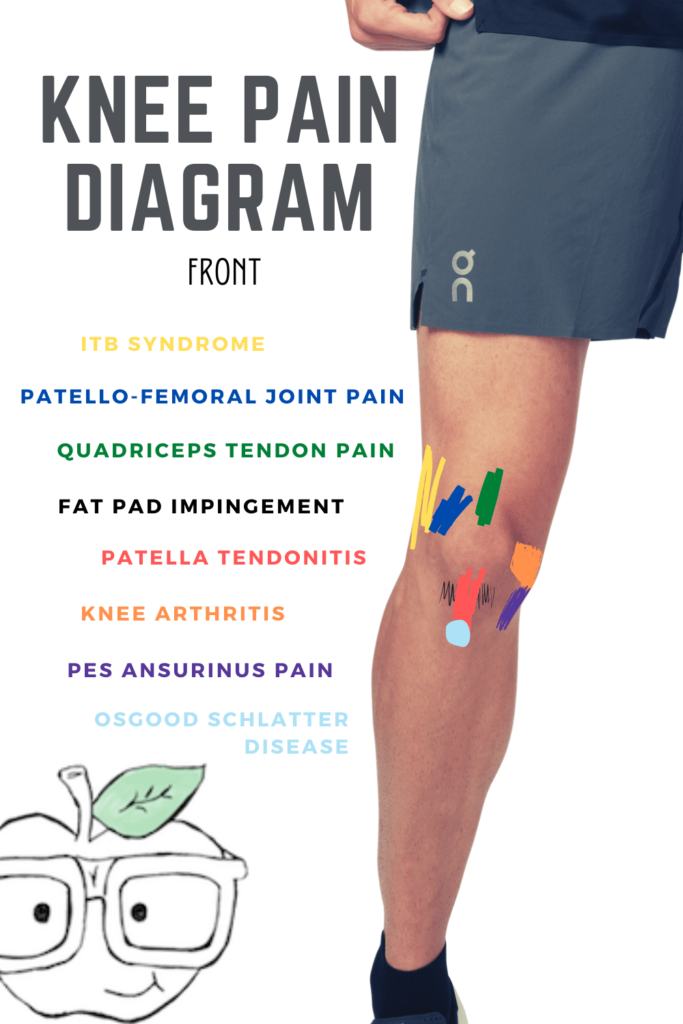Let’s talk about the cause of knee pain. More importantly, I want to discuss why it’s not just the knee you should be thinking about.
Knee pain is so common that it affects 25% of all adults in some way, shape or form.
Terms such as growing pains, knee tendonitis, meniscal tears, patellofemoral pain, Iliotibial band syndrome, arthritis, etc, are all becoming more widely recognized and understood by the general public.
In short, there's every chance you may suffer from knee pain, or you know someone who does.
Yet despite how common it is, we still often lack the necessary perspective to understand the underlying cause of knee pain. Interestingly, it's not often what you'd immediately expect.
So, as a Physiotherapist, here is what I've come to understand are the most common (and often hidden) causes of knee pain.

Knee Pain Is a Consequence
As I'm sure most are aware, the knee's primary role is to hinge backward and forward. However, we often forget its connection to the ankle and hip. It's literally stuck in the middle and at their mercy.
A joint of consequence if you will.
The knee is not the isolated joint many see it as. It’s just one aspect of your leg. It all works together.
This tendency to miss the bigger picture can make it hard to understand your knee pain. It's hard to solve the whole puzzle if you don't have all the pieces.
As a Physio, it seems that most feel their knee pain just “happens". Accidents happen of course, but for the majority of us, our knees feel fine until they aren't.
And this experience often masks a raft of hidden issues going on behind the scenes. After all, our knees are designed to support us throughout our entire life. Why have them if they so often fail without incident?
What Is the Cause of Knee Pain?
A great way to understand the true cause of knee pain is to think of it like this:
Consider the onset of your knee pain the last straw rather than the beginning of something new.
Yes, it didn’t hurt until it started hurting, but its role within the leg means it’s prone to compensate for hidden dysfunction above and/or below it.
Clinically, there seem to be three major areas that, when restricted, will change the way you load the knee.
The Ankle:
Thanks to modern heeled shoes and thongs (flip flops) our ankles have a tendency to be stiff.
Mechanically, a rusty ankle forces the entire leg to rotate inwards in an attempt to maintain some functional equilibrium.
This can often lead to knee pain on the inside or outside of the knee.
Related: Read why modern footwear is setting our ankles up to fail.
Test Your Ankle Flexibility:
Squat as deep as you can while keeping your heels down and feet straight.
Next, squat again but allow your heels to lift and/or your feet turn out if needed. You should find it easier the second time.
This highlights how your body will try to compensate for a tight ankle.
Similarly, you may also notice your knees will likely track inwards relative to where your feet are pointing. This completely alters the loading pattern of your knee from a basic hinge to one with a twist.
Sure, you may have got lower the second time, you are unknowingly asking those knees to buffer poor mechanics in the long run. Remember, they'll cope until they don’t. All because of some innocuous ankle stiffness below the knee.
Ankle Exercise to rectify: Banded Ankle Stretch
Here's a more in-depth video on the Banded Ankle Stretch.
The Hip:
The knee will also have to compensate if the front of your hip is tight. Much like the effects of heeled shoes, our hips have their own modern-day challenges. And this generally takes the form of too much sitting.
When walking, notice what your back leg is doing as it trails behind. Tightness at the front of the hip will ask your leg to rotate outwards to find more room.
If you watch others walk you’ll notice a high proportion of turned out feet. This can create further consequences at the knee as it functions optimally with a straight foot.
To compound this, tight hip rotators can make things like sitting cross-legged uncomfortable for your knees. If this is you, then it’s likely your knees aren't enjoying that lack of hip range!
Exercise to rectify: The Couch Stretch (Front)
Related: The Couch Stretch: One of the Greatest Stretches You'll Ever Do.
Pigeon Pose (Deep Rotators)
The Low Back:
Stiff lower back segments have a direct and indirect role in the cause of knee pain. If your back is stiff, surrounding musculature will tighten in support.
The hip flexors, in particular, can get caught up in this as they attach to the front of your lower back. This again forces the leg to find a rotational workaround with long-term ramifications for the knee.
Similarly, the nerves that supply the function of the knee exit from your lower back and can become physically over-tensioned. This can pull slack from, and tighten any tissue associated with the nerve as it travels down the leg. For example, if kneeling and sitting fully back on your heels is uncomfortable, it's likely your quadriceps are tight. This restriction is often a consequence of back stiffness/increased neural tension.
Related: Here's what I've come to understand about Knee Tendonitis and Osgood Schlatter Disease.
Exercise to rectify: Lacrosse Ball or Foam Roller
Here's a simple way to mobilize a stiff back with a ball.
How to Best Manage Your Knee Pain Once It's There
Like most pain and dysfunction the best way to treat knee pain is highly individualized. However, there are some essential basics to lay the foundation for optimal recovery.
1. Improve Your Leg Mechanics
As mentioned above, work hard on improving the way you load your knee.
Optimize its function by freeing up your ankles, hips and low back.
Once you remove some of these hidden handbrakes, any irritated and sore knee tissue can begin to settle even before you've directly treated the area.
If you want your knee pain to go away (and stay away) it's vital that you go after its mechanical cause.
2. Feed Slack to the Knee Itself
Similar to freeing up the joints above and below the knee, go after any restricted tissue around the knee.
Take a foam roller or massage ball to your calves, hamstrings, and quadriceps. Regardless of your specific diagnosis, you will likely have some tight tissue either side of the knee and above the knee cap.
Work on freeing these areas up and you may find some more immediate symptomatic relief.
3. Avoid Using Ice and The RICE Protocol
This one can take a moment to sink in but give ice and the RICE protocol a miss. Basically, it may be slowing down your recovery.
Despite having used ice and the RICE protocol to treat pain and injury for over 40 years now, there's a strong disconnect between why we use it and what the body is trying to achieve on its own.
We typically ice to reduce pain, swelling, and inflammation despite these not only being normal but vital for optimal healing.
We preach rest despite the body needing movement to flush out accumulated swelling and promote optimal tissue regeneration and remodeling.
Similarly, we also compress our sore and injured tissue in an attempt to limit swelling coming into the area, despite it also limiting optimal waste removal.
And finally, we elevate to help swelling removal but also limit blood flow - the one thing carrying the cells and nutrients necessary to support the healing process.
It's worth noting that ice is an effective pain reliever, but one that comes with a hidden cost.
4. Encourage Respectful Pain-Free Movement
With controversy now surrounding the use of ice to treat all pain and injury, it's important to use other techniques to help your knee recover.
With this in mind encourage as much respectful, pain-free movement as your condition allows. Engage the muscles around your knee by simply tensing and relaxing them. Bend your knee or go for a walk if it's appropriate for you.
Your body needs a certain amount of motion to allow optimal recovery - you just need to work out what your threshold is. All it often takes is to listen to your body. Too much use may cause extra pain, swelling, and inflammation. Too little won't facilitate progress. Speak with your Physiotherapist (Physical Therapist) to work this out if needed.
5. Improve Your Strength
Again, this may be the realm of a trusted Physiotherapist but it's very important to strengthen your knee where possible.
Pain, swelling, and fluid on the knee can inhibit muscle function. If left unchecked, this can lead to a spiral of dysfunction.
Make sure that you are improving the strength of the following muscles:
- Gluteals
- Quadriceps (more specifically the inner quad)
- Trunk/Core
- Calf
- Hamstrings
It's important to note there will always be a level of strength training appropriate for you.
Much like the ankle, hip, and low back mobility exercises, sometimes it helps to target your calves, glutes, and core first before addressing the knee itself. This will again help improve the way you load the knee making it easier to specifically load the knee later on.
6. Knee Taping
If your knee pain is persistent consider the short-term use of rigid taping. If performed correctly tape can provide much-needed support and control to the area.
When we consider most non-traumatic knee pain to be a consequence of poor leg mechanics and loading, tape can be a highly effective way to correct any poor loading while the broader mobility and strength exercises take effect.
Similarly, a knee brace may also help improve your quality of life in the short-term. It is however vitally important to see these tools as short-term commitments only. They will not cure your knee pain on their own. You should distance yourself from them as your condition improves.
Frequently Asked Questions
If you'd have asked this question 5-10 years ago, the answer would be an obvious yes. A Doctor might assess your knee, offer broad advice, prescribe you pain relief or anti-inflammatories, and potentially send you off for a scan. However, the model is now changing. Thanks to the internet, information sharing is at an all-time high and the role of Physical Therapy (Physiotherapy) has become central to the management of knee pain.
With direct access laws now allowing people to bypass a Doctor's referral, the role of a Doctor in treating knee pain has rightfully reduced. Their ability to prescribe appropriate medication and necessary scans are worthwhile, however, the expertise of our Health Professionals has now surpassed that of the more generalized specialties of the local Doctor. As of today, treatment of knee pain still has the potential to be a collaborative effort between a Physical Therapist and Doctor, however, the balance has rightfully shifted towards the more specialized Health Professionals.
Knee pain going up stairs is common for many people, particularly as we get older. However, the important distinction to make here is that knee pain going up stairs does not happen because we age, nor because we are actually going up stairs (or down stairs), as strange as that sounds.
In reality, the mechanics of your leg and how you load up the knee is the most important factor in determining knee pain. In this instance, going up stairs is unlikely to be the cause of your knee pain, it's more likely to be the activity that exposes poor underlying mechanics - of which the knee tissue is not tolerating.
As mentioned in this article, knee pain is often the consequence of something else. And with knee pain going up stairs, the number one feature to consider looking in to is the mobility of your ankles.
Walking up and down stairs requires more ankle range of motion than walking on a flat surface. Any significant degree of ankle stiffness forces the entire leg to cave inward in order compensate for that lack of ankle range. Over time this can overload, irritate, and even wear down the tissue in the knee setting you up for knee pain, particularly with stairs.
Improving your ankle mobility (banded ankle stretch above) and reclaiming good squat form are two quick and simple exercises to help improve the root dysfunction setting you up for knee pain when going up the stairs.
Knee pain when squatting is often a consequence of issues with the broader leg. Stiff ankles, tight hip flexors, a stiff hip joint and stiffness in the lower back can all set the knee up to fail when squatting.
Squatting requires access to more range of hip, knee, and ankle range of motion that something like walking, and dysfunction in these areas are exposed the deeper you try and squat.
Regardless of the type of knee injury or knee pain from squatting, it's important to work hard on improving the overall function of your lower half, not just the knee-specific consequences/symptoms.
If you experience knee pain when running, it is important to make sure you do not blame running. Clinically, running does not cause knee pain, but it will expose poor underlying mechanics and loading patterns accrued from modern living.
In short, we take hidden dysfunction from our day to day lives in to running and it eventually fails to tolerate the repetitive loading.
As a rule, knee pain either side of the knee has more to do with a lack of hip and ankle mobility and hip weakness, whereas pain through the patella and quads tendons may have more to do with low back dysfunction.
Knee pain injections can provide those who have them with some knee pain relief. However, injections for knee pain should always be looked at as a short-term, symptomatic treatment at best. Because of this, knee pain injections are highly unlikely to cure knee pain.
Instead, they should be considered as a way to help manage moderate to extreme pain, or pain that highly restricts day-to-day function, so that you can work hard on the root cause of your pain more effectively.
Conclusion
So with all this in mind, there are some important things to remember when trying to uncover the cause of knee pain. If you have a sore knee or know someone who does, take a step back.
Consider how your ankles, hips and low back are also going. Sure they may not hurt but they do weild a powerful influence over the knee. After all, they share a physical and mechanical connection. It's just often hard to appreciate if you’re not looking for it.
At the end of the day, this is a lesson in perspective. It’s important to understand almost everything that happens to the knee is a consequence of something else. You just need to take a big enough step back to appreciate what it actually is.
If you can make a positive change to these other areas you'll hopefully surprise yourself with how your knees start to feel.
Good luck!
If you'd like help trying to uncover the underlying cause of your knee pain, consider booking in an online Telehealth consultation with Grant here!


